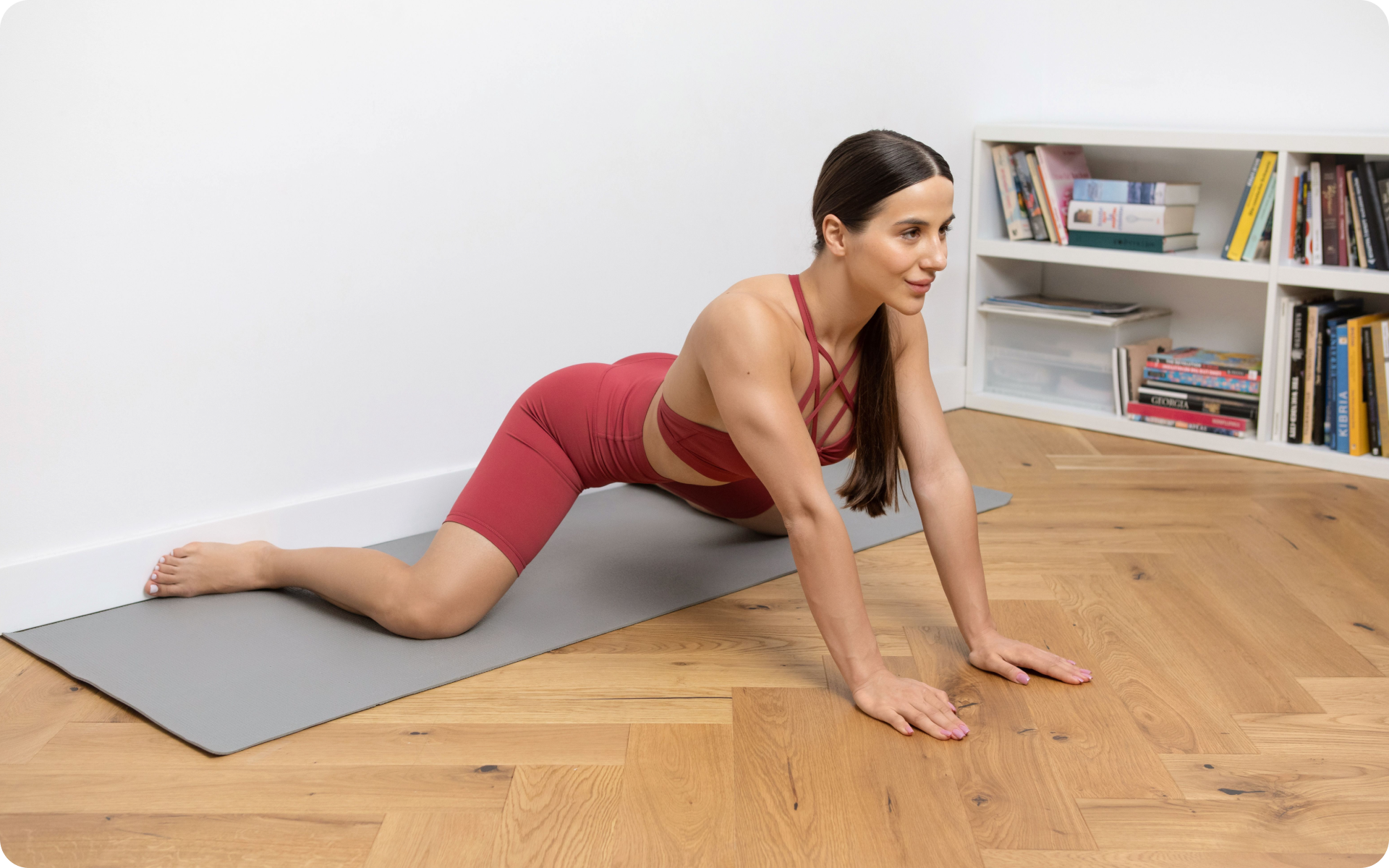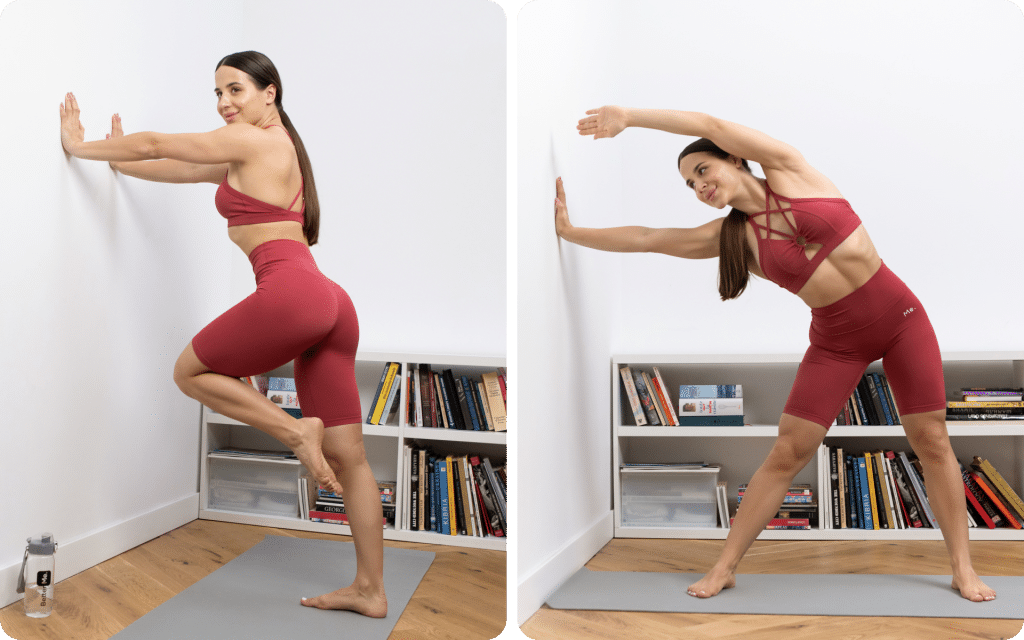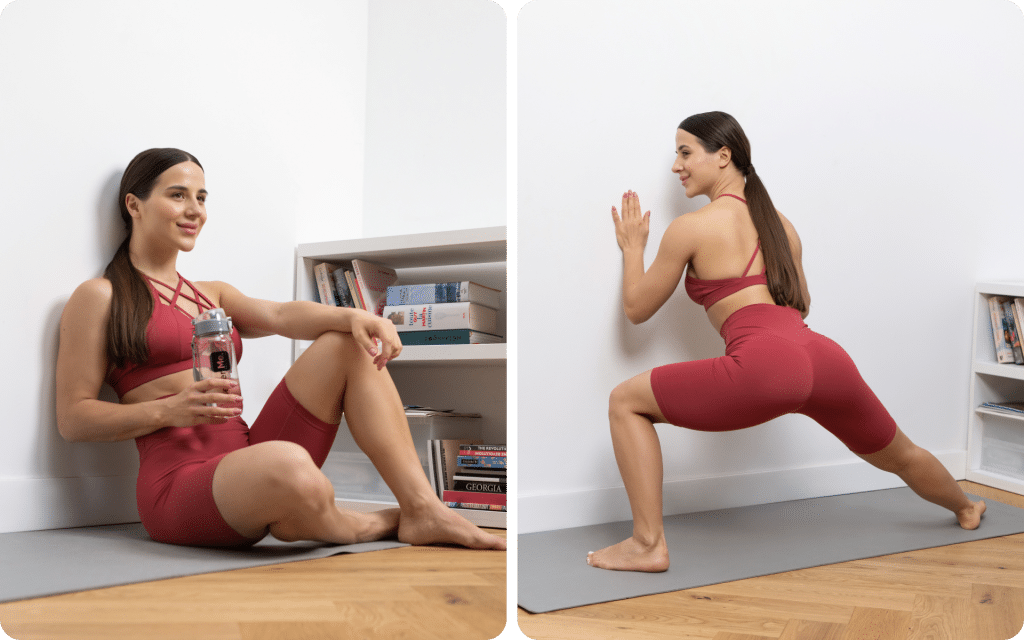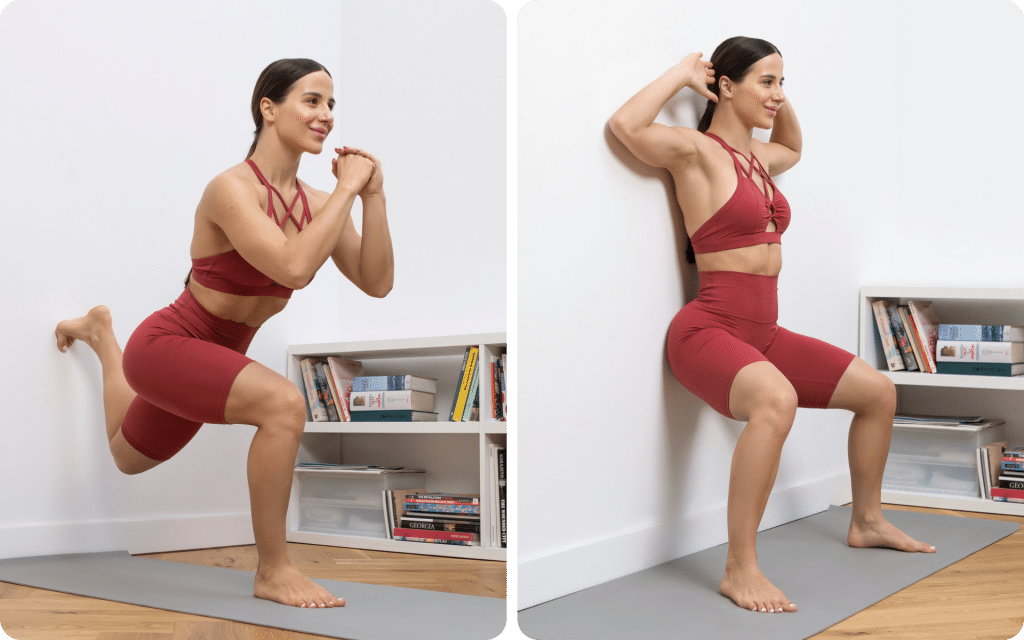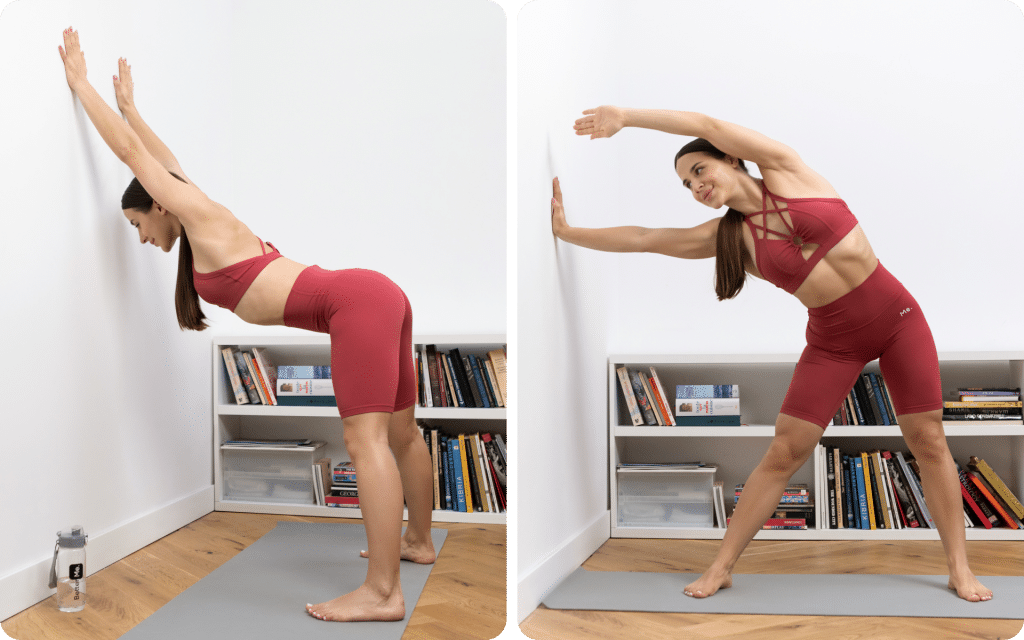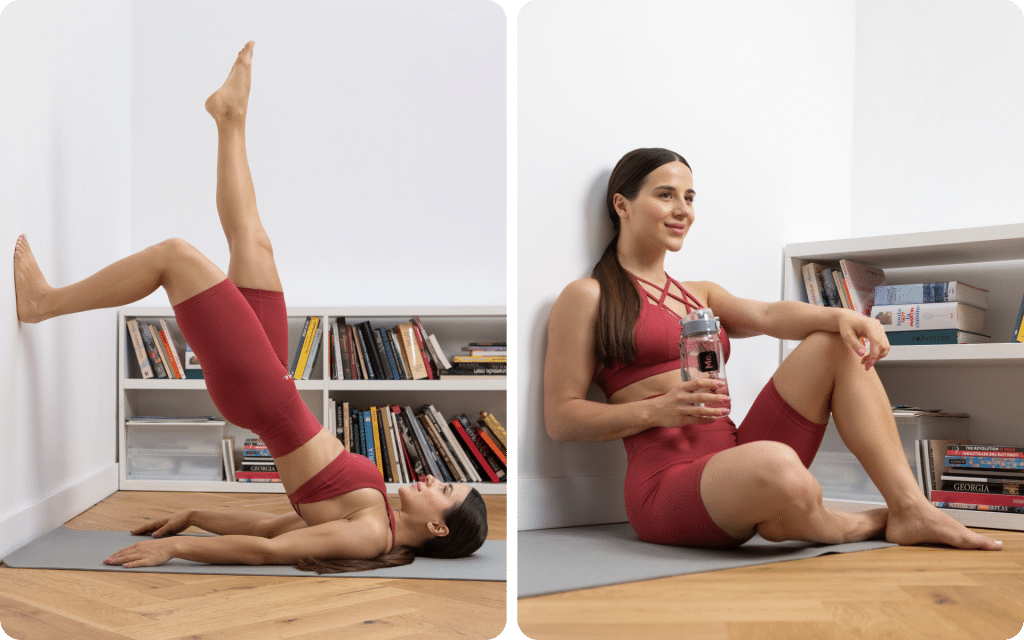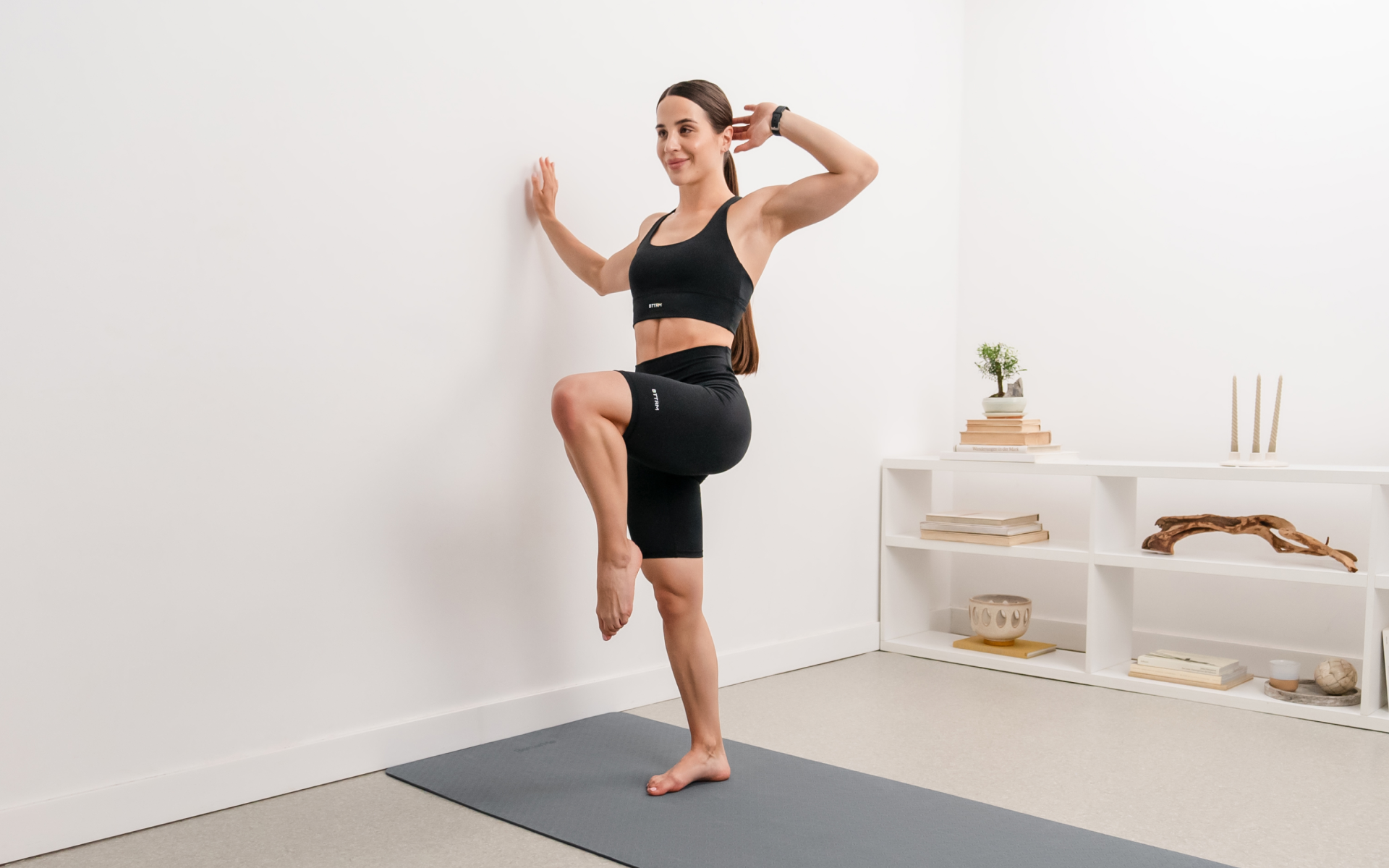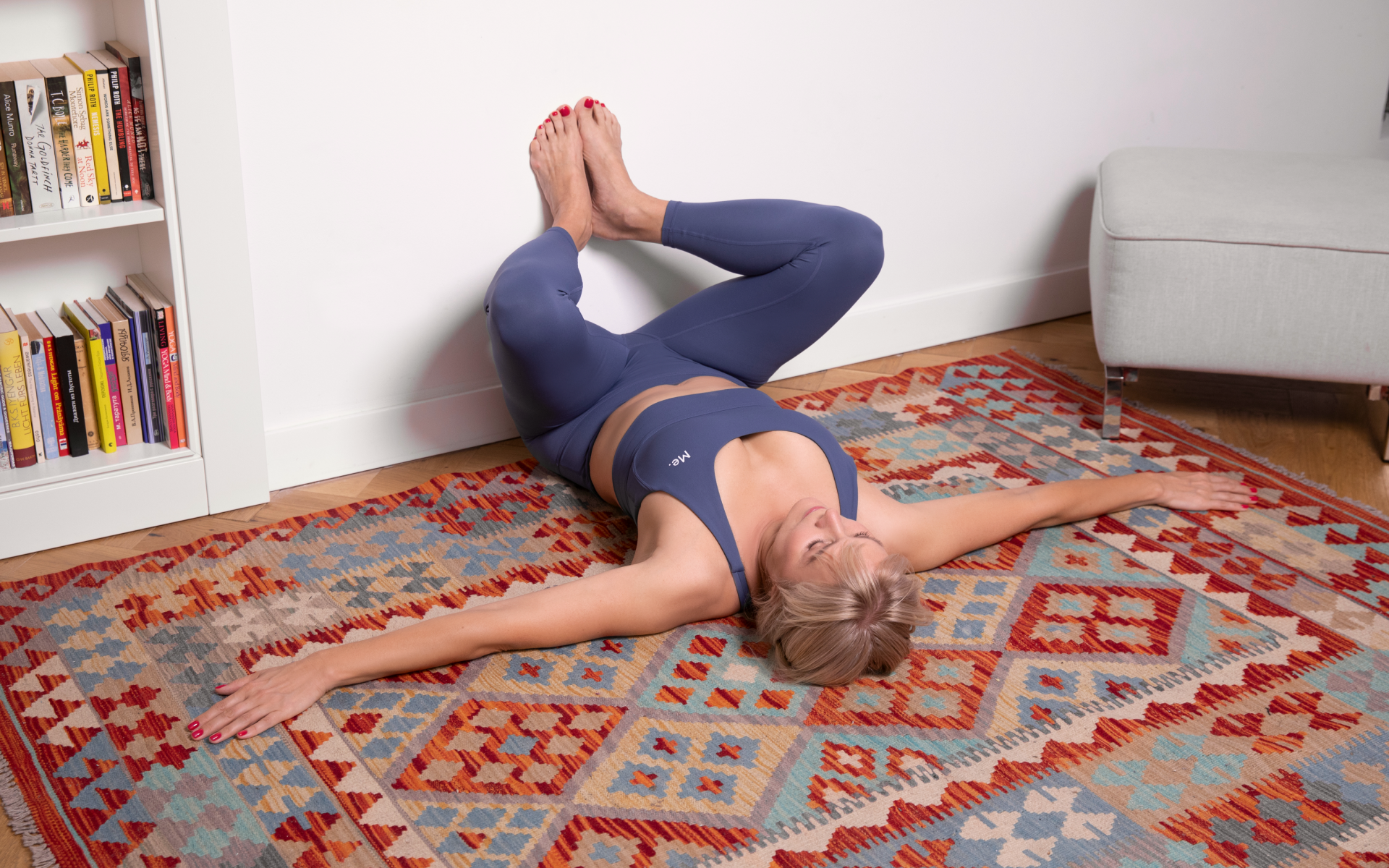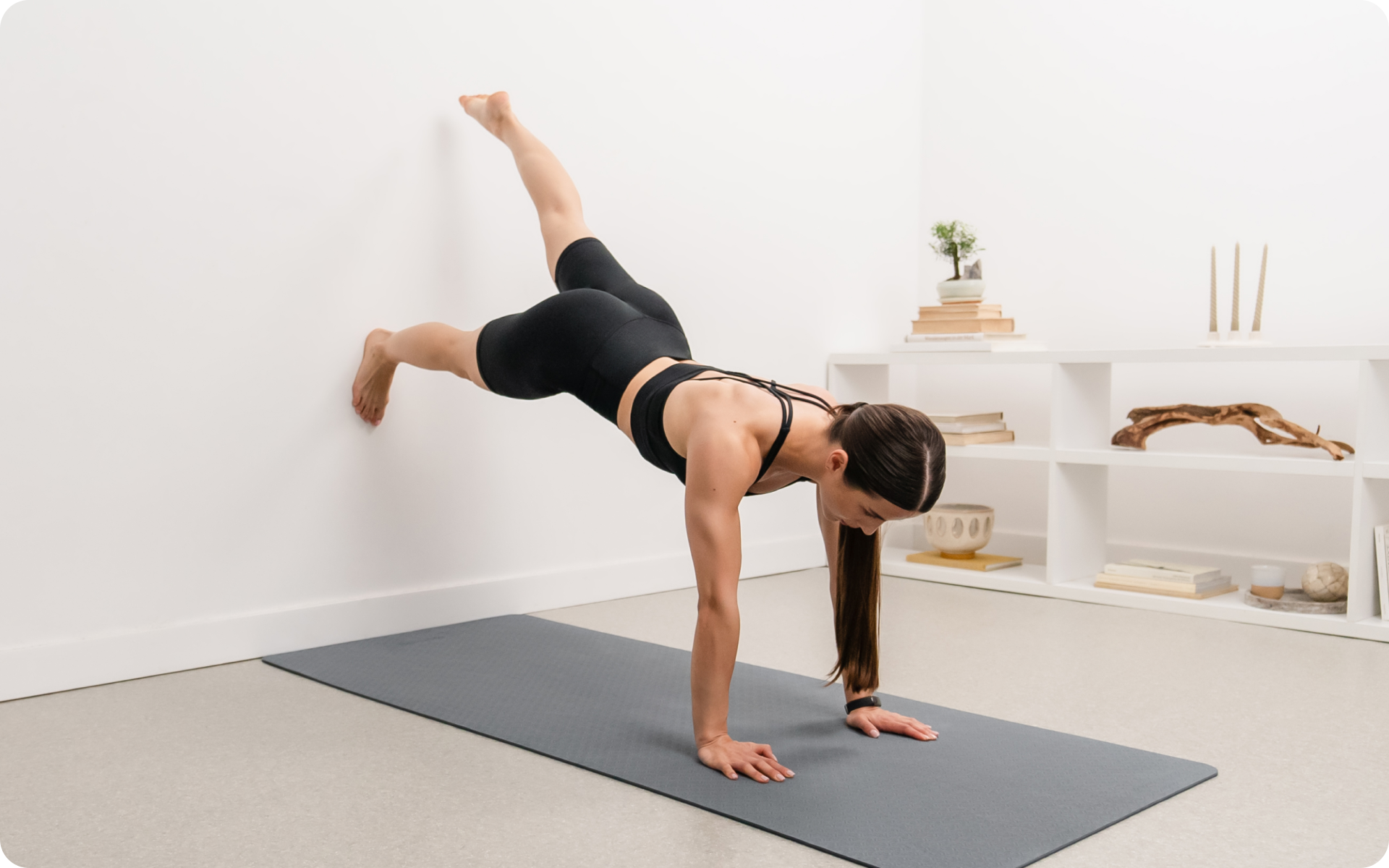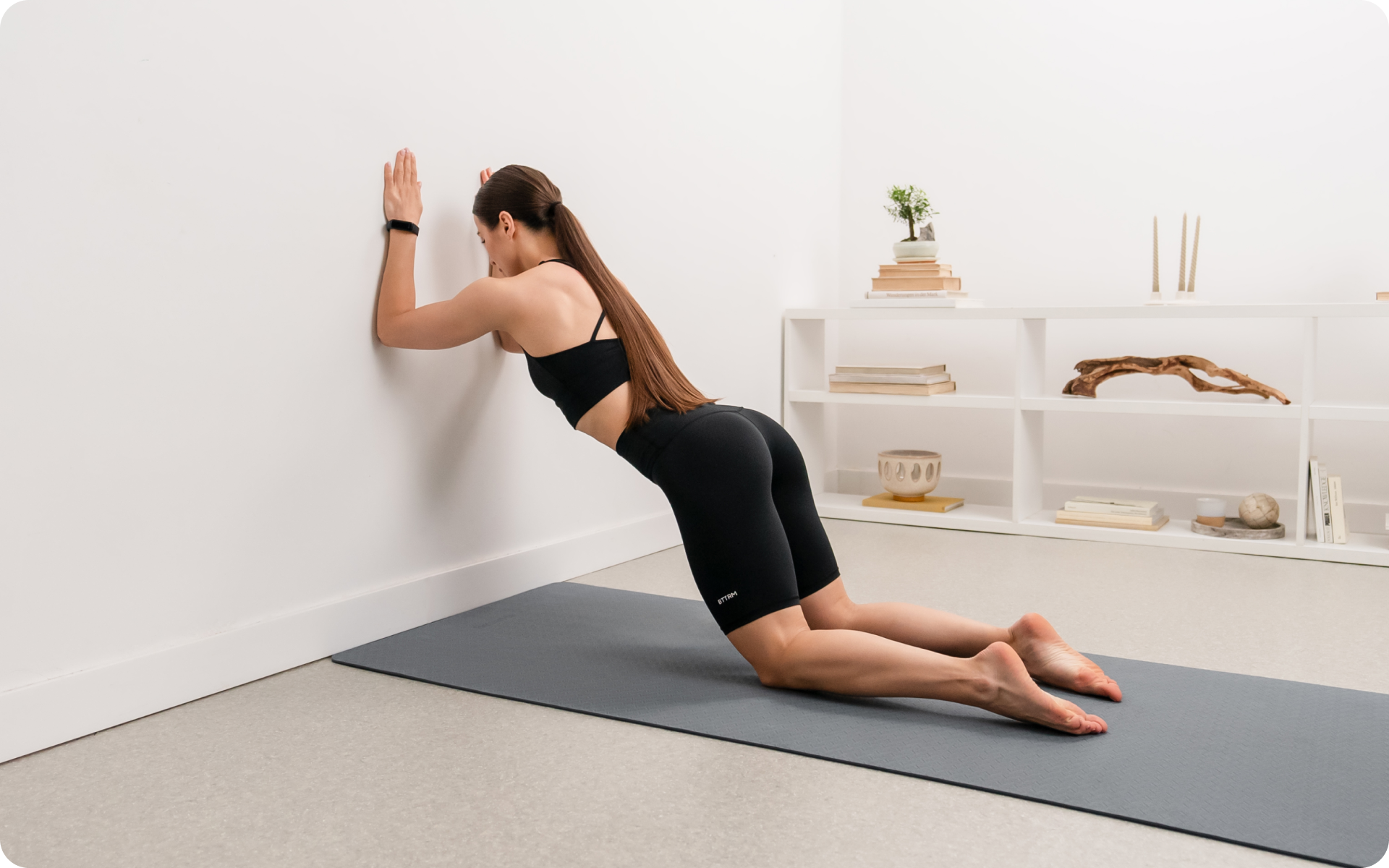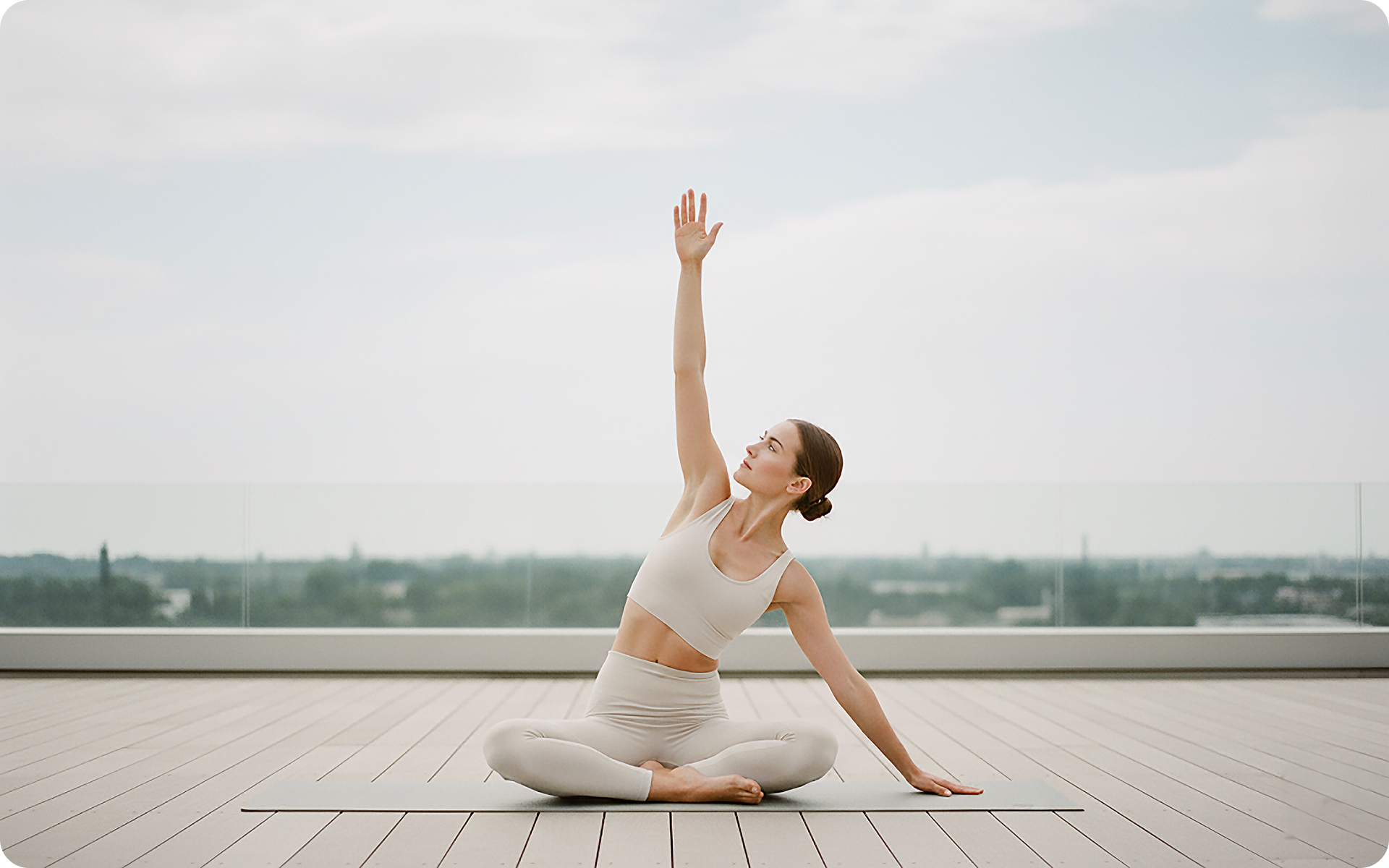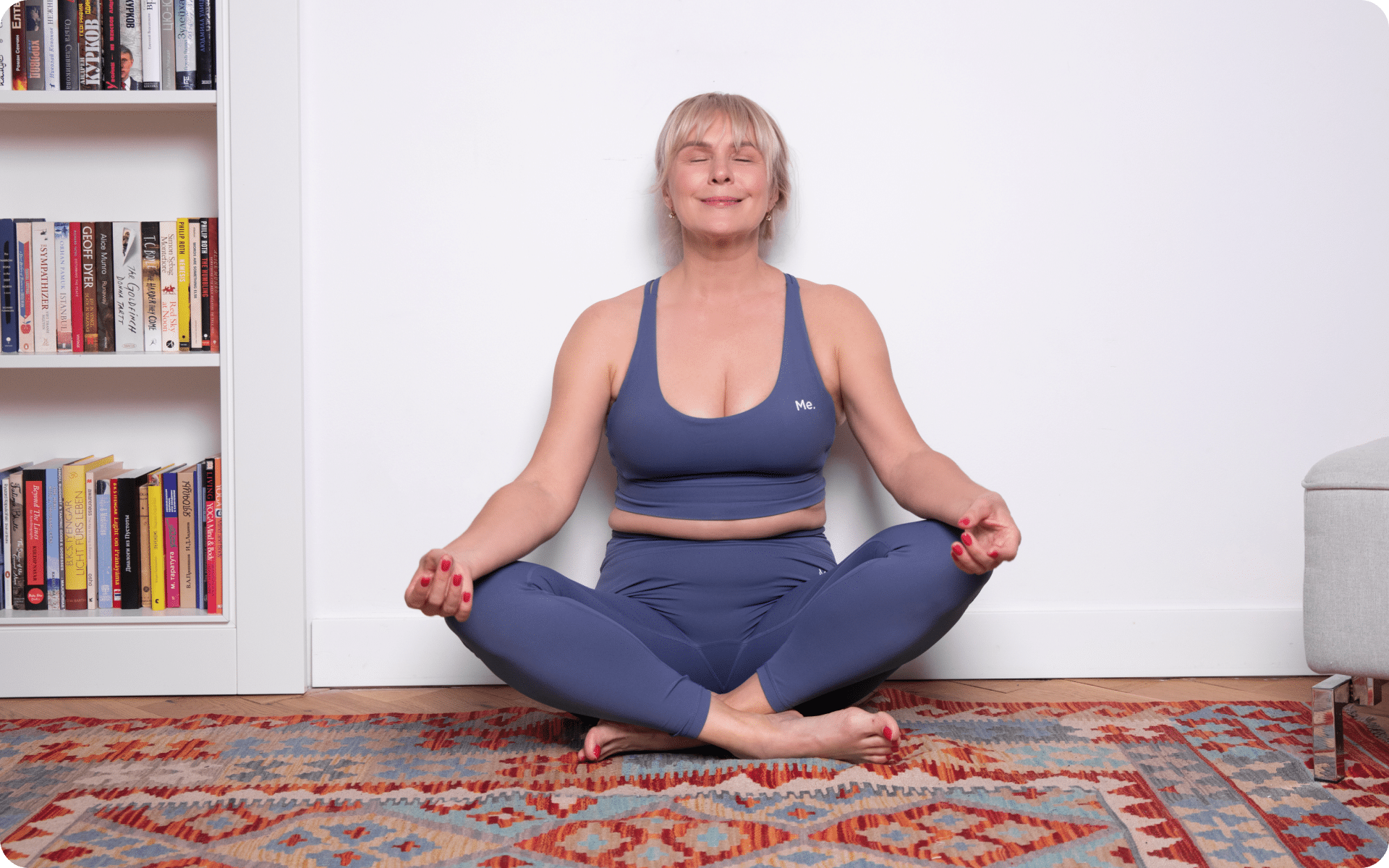Not everyone can jump straight into high-intensity workouts when they’re trying to lose weight. For some, gentle, low-impact exercise is not just an option but a necessity.
Chronic pain, injury, mobility issues, or simply starting from a lower fitness level can make intense activity feel out of reach. And that’s okay. Movement in any form can still offer benefits.
This brings us to wall Pilates. Known for its accessibility and focus on controlled movements, it’s often praised for building strength, improving flexibility, and increasing body awareness. But can it also help with weight loss? That’s a more nuanced question and one we’ll carefully unpack here.
What Is a Wall Pilates Weight Loss Plan?
A wall Pilates weight loss plan is a structured routine that is focused on low-impact exercises performed with the support of a wall. This type of plan is designed to improve strength, flexibility, and movement control while being gentle on your joints. For someone who is looking for a manageable way to start exercising with the goal of weight loss, it can provide a solid foundation.
Here’s what such a plan could look like:
Core focused movements – A wall Pilates plan emphasizes engaging your core muscles (the muscles around your abdomen, lower back, and pelvis). It may include exercises such as wall roll-downs or wall-supported planks where the wall helps stabilize you.
Full-body routines – Your plan shouldn’t just target one area. Expect movements that work the whole body, such as wall squats, standing leg lifts, or arm circles against the wall.
Gentle stretching and flexibility work – Many wall-based exercises include gentle stretches, such as standing hamstring stretches or wall-assisted spinal twists. These help improve your range of motion and reduce stiffness, which is particularly beneficial if you have a more sedentary lifestyle.
Tailored intensity – A wall Pilates plan can be easily modified to suit your fitness level. For example, if you’re new, you may start with just 15-20 minutes, 2-3 days a week. You could then gradually increase the workout to 4-5 days a week, aiming for 30-40 minutes per session. The exercises themselves can also be adjusted, with options for easier or more challenging variations.
Mind-body connection – Pilates is more than just movement – it teaches awareness of your body (1). A wall Pilates plan often integrates slow, mindful breathing with every exercise. This promotes relaxation, improves focus, and helps you stay present during workouts.
Active rest days – Active recovery refers to light activities that keep you moving between more intense workouts (2). If your plan includes other exercise forms, you can use wall Pilates on “off” days to stretch and recharge.
Is Wall Pilates Good for Weight Loss?
Wall Pilates can be a good addition to a weight loss plan.
Weight loss typically requires burning more calories than you consume, which is often referred to as creating a calorie deficit (3). Exercises that increase heart rate and engage large muscle groups tend to burn more calories (4).
However, wall Pilates leans toward low-intensity exercise. While it strengthens muscles and improves flexibility (5), its calorie burn is lower than that of high-intensity workouts such as running or cycling.
For context, a 30-minute wall Pilates session may burn approximately 120-180 calories, depending on your weight and effort level. That’s less than what you’d burn with more vigorous activities.
That being said, there’s more to weight loss than a strict calorie count (6). Wall Pilates offers distinct benefits that can support your weight loss efforts and overall fitness.
Contributes to Daily Calorie Expenditure
While wall Pilates doesn’t burn a lot of calories in a single session, it still gets you moving. For individuals who are new to exercise or returning after a long break, it introduces sustainable physical activity.
Regular movement, even at lower intensities, is better than a sedentary lifestyle. It creates a foundation for daily calorie expenditure, which can be further enhanced with gradual increases in intensity or the addition of other activities.
Reasons why BetterMe is a safe bet: a wide range of calorie-blasting workouts, finger-licking recipes, 24/7 support, challenges that’ll keep you on your best game, and that just scratches the surface! Start using our app and watch the magic happen.
Building and Strengthening Muscle
Wall Pilates emphasizes controlled, precise movements that engage multiple muscle groups, particularly the core, legs, and arms (5).
Gaining muscle is beneficial for weight loss as muscle tissue burns more calories at rest than fat tissue (7). While the increase in resting calorie burn is modest, stronger muscles support other activities, allowing you to eventually engage in higher-intensity workouts if desired.
Improving Mobility and Functionality
A significant barrier to weight loss for some people is restricted mobility caused by joint pain, stiffness, or lack of flexibility. Wall Pilates improves range of motion through gentle stretches and controlled movements, such as spinal twists or hamstring stretches. Better mobility makes everyday tasks and other types of exercise more accessible, which encourages an active lifestyle.
Encouraging Consistency and Routine
One of the most overlooked aspects of weight loss is consistency. Wall Pilates is approachable and has a low barrier to entry, which makes it easier to stick with over time. Its low-impact nature ensures you can integrate it into your routine without overexerting or risking injury, which is particularly helpful for beginners. Regular participation in any exercise helps reinforce healthy habits, making it essential for long-term success.
Boosting Mind-Body Awareness
Wall Pilates focuses on the connection between movement and mindfulness. By practicing controlled breathing and paying attention to how your body moves, you become more aware of your posture and alignment (8). This awareness can extend to other fitness activities, which makes them safer and more effective. It might also help improve your relationship with exercise, reducing burnout and promoting a positive outlook on physical activity (9).
Supporting Recovery and Stress Relief
Recovery is essential for weight loss, as overtraining or chronic stress can hinder progress. Wall Pilates is gentle enough to serve as active recovery on days when you’re resting from heavier workouts. It also encourages relaxation through deep breathing and low-impact movements, helping to lower stress levels, which can influence weight management by reducing cortisol, a stress hormone that is linked to fat retention (10).
Read more: Wall Pilates for Back Fat: 9 At-Home Exercises
Will Wall Pilates Flatten the Stomach?
Wall Pilates cannot directly “flatten” the stomach, as spot reduction (targeting fat loss from a specific body area) is not physiologically possible. Visible flattening of the stomach mostly depends on reducing overall body fat, which requires a combination of dietary changes, full-body calorie-burning activities, and resistance training (11).
However, what it can do is strengthen and tone the abdominal muscles.
Many wall Pilates exercises, such as wall roll-downs or wall planks, focus on engaging the core muscles, which include the rectus abdominis (the “six-pack” muscle), obliques, and transverse abdominis (a deep core muscle that acts like a corset).
Consistent engagement of these muscles can improve posture and create a more toned appearance over time. A strong core also supports better movement in daily activities and reduces the risk of injury (12).
Is 30 Minutes of Pilates a Day Enough to Lose Weight?
30 minutes of Pilates a day can contribute to weight loss, but whether it’s “enough” depends on factors like your calorie intake, activity level, and individual metabolism. Pilates, including wall Pilates, is primarily a low-intensity exercise. While it builds strength, improves flexibility, and enhances muscle control, its calorie burn remains moderate compared to higher-intensity activities such as running, swimming, or weightlifting.
For many people, adding 30 minutes of Pilates to their daily routine is a great way to promote consistency in movement, which is the key for weight management. It’s also useful for improving mobility and muscle endurance.
However, to meet standard physical activity guidelines for weight loss, you may need to incorporate more vigorous activities into your routine. For example, aerobic exercises or strength training with heavier resistance are more effective at increasing overall calorie expenditure.
How Many Calories Does Wall Pilates Burn in 30 Minutes?
The number of calories burned during a 30-minute wall Pilates session depends on your weight, effort level, and overall fitness. A 150-pound person may burn approximately 120-150 calories in 30 minutes of gentle wall Pilates. Engaging in more challenging variations or holding positions longer may increase the calorie burn to about 180 calories for the same individual.
Can Pilates Change Your Body in 2 Weeks?
Pilates can lead to noticeable changes in how your body feels and functions within two weeks, but you may not notice any visible physical transformations in this time.
Two weeks of consistent practice can help you:
- Tune into your breathing
- Become more mindful of how you move
- Feel stronger and more aware of specific muscle groups such as the core, glutes, and legs
- Bending, twisting, or reaching feels easier and less stiff, particularly if you were relatively inactive before starting Pilates
Visible physical changes typically require more time and depend on factors such as diet, exercise intensity, and overall activity levels.
What Is an Effective Wall Pilates Weight Loss Workout Plan?
Below is a structured workout plan that can be completed within 30 minutes.
It includes rest times to ensure proper recovery between sets while maintaining the intensity required:
- Wall Sit with Arm Raises
- Reps: 10-12
- Sets: 3
- Rest: 30 seconds between sets
- Wall Plank with Knee Tucks
- Reps per leg: 10-12
- Sets: 3
- Rest: 30 seconds between sets
- Wall-Assisted Glute Bridge
- Reps: 12-15
- Sets: 3
- Rest: 30 seconds between sets
- Wall Press Leg Lifts
- Reps per leg: 12-15
- Sets: 3
- Rest: 30 seconds between sets
- Wall-Assisted Mermaid Stretch
- Hold per side: 15-20 seconds
- Rounds per side: 2
- Rest: No rest, alternate sides
- Wall Push-Off Squats
- Reps: 12-15
- Sets: 3
- Rest: 30 seconds between sets
- Wall Shoulder Stretch with Roll-Down
- Reps: 8-10
- Sets: 1
- Rest: No rest
- Final Stretch with Wall Support
- Hold stretch for 15-30 seconds
- Rounds: 1
Wall Sit with Arm Raises
This exercise strengthens the legs, glutes, and shoulders while engaging your core for stability.
- Stand with your back flat against the wall and your feet about two feet away from it, hip-width apart.
- Slide down the wall into a seated position with your thighs parallel to the floor and your knees directly above your ankles.
- Hold small hand weights (optional) and raise your arms straight out in front of you to shoulder height.
- Lower your arms slowly and repeat for 10-12 reps.
- Return to standing to rest if needed, then repeat for 3 sets.
Wall Plank with Knee Tucks
This engages your core, shoulders, and legs while using the wall for stability.
- Place your hands on the floor, shoulder-width apart, with your feet pressed against the wall at hip height.
- Your body should form a straight-line plank position from your head to your feet.
- Slowly tuck one knee toward your chest, keeping your core tight.
- Return your foot to the wall and repeat with the other knee.
- Alternate for a total of 10-12 reps per leg, resting after each set. Complete 3 sets.
Wall-Assisted Glute Bridge
This move strengthens the glutes, hamstrings, and core while the wall provides added stability.
- Lie on your back with your feet elevated and flat on the wall. Your knees should bend at about a 90-degree angle.
- Press your lower back into the mat and lift your hips toward the ceiling. Squeeze your glutes at the top of the movement.
- Lower your hips slowly without touching the floor.
- Repeat for 12-15 reps. Perform 3 sets, resting between them.
Wall Press Leg Lifts
This targets the lower abs, thighs, and hip flexors.
- Lie on your back with your legs extended upward and your feet pressing lightly against the wall.
- Place your arms along your sides for support.
- Keeping your feet in contact with the wall, lower one leg toward the floor without letting it touch.
- Return to the starting position and switch legs.
- Alternate for 12-15 reps per leg, completing 3 sets.
Wall-Assisted Mermaid Stretch
This stretch focuses on lengthening the sides of your body while improving mobility and flexibility.
- Sit sideways with your right hip against the wall and your legs bent and tucked to your left side.
- Place your right hand on the floor for support and extend your left arm overhead.
- Lean slightly toward the wall, feeling a stretch along your left side. Hold for 15-20 seconds.
- Switch sides and repeat. Complete 2 sets on each side.
Wall Push-Off Squats
This dynamic movement strengthens your legs and engages your core for stability.
- Stand about two feet away from the wall, facing it, with your feet hip-width apart.
- Lean forward slightly and place your hands flat on the wall at shoulder height.
- Perform a squat by pushing your hips back as you bend your knees, keeping your back straight.
- Push off the wall gently as you return to standing, engaging your glutes.
- Repeat for 12-15 reps. Perform 3 sets in total.
Wall Shoulder Stretch with Roll-Down
This combines flexibility and mobility work for your shoulders, back, and hamstrings.
- Stand facing the wall with your arms extended straight at shoulder height, your palms pressing into the wall.
- Take a step back, hinge at your hips, and lower your torso to create an L-shape with your body.
- Push your palms into the wall to stretch your shoulders and upper back.
- Slowly roll up to stand, engaging your core and stacking your spine one vertebra at a time.
- Complete 8-10 slow, controlled reps.
Final Stretch with Wall Support
Always finish with a gentle stretch to release tension and promote muscle recovery.
- Sit with your back flat against the wall and your legs extended straight in front of you.
- Lean forward slightly, reaching for your toes or shins to stretch your hamstrings.
- Hold for 15-30 seconds, breathing deeply.
Explore more exercises that you can incorporate into your routine in our guide – Wall Pilates Workout For Beginners.
Read more: Does Wall Pilates Really Work For Weight Loss?
Why Am I Not Losing Weight with Pilates?
If you’re not losing weight with Pilates, it doesn’t mean your efforts are wasted. You may need to fine-tune your approach by looking at your diet, the intensity of your workouts, or your overall lifestyle.
Here are some reasons why you’re struggling:
- You’re Not in a Calorie Deficit
Weight loss happens when you burn more calories than you consume, creating what’s known as a calorie deficit (13). While Pilates strengthens your muscles and improves mobility (5), it doesn’t burn as many calories as higher-intensity exercises such as running or cycling. If your diet provides more calories than your body uses, regardless of how much Pilates you do, you won’t see the scale move.
Consider tracking your calorie intake and balancing it with activities that boost overall calorie expenditure. Adding a brisk walk, swim, or short jog on non-Pilates days could help you shift toward a calorie deficit.
- Your Workouts Lack Intensity
Pilates focuses on controlled, low-intensity movements that build strength and improve flexibility (5). While these movements are wonderful for overall fitness, this doesn’t always translate into high calorie burn. If your sessions feel easy or don’t challenge you, they may not be helping your metabolism as much as you think.
To maximize the results, you can vary your routine by including Pilates exercises that raise your heart rate, such as wall planks or dynamic squats. Incorporating interval-style movements or holding exercises for a longer duration can also increase the intensity.
When it comes to weight loss, progress is made by inches, not miles, so it’s much harder to track and a lot easier to give up. The BetterMe: Health Coaching app is your personal trainer, nutritionist, and support system all in one. Start using our app to stay on track and hold yourself accountable!
- You’re Not Being Consistent
Consistency is the key for any fitness goal, including weight loss. If your Pilates practice is sporadic or you only do it once a week, your body may not be reaping the full benefits. Regular movement creates a routine for your muscles, increases energy expenditure, and builds discipline (14).
Try scheduling Pilates sessions at least three to four times a week and stick to your plan. Over time, the consistency will complement your broader weight loss efforts.
- Your Diet Isn’t Supporting Your Goals
Even the best workout routine can’t overcome an unbalanced diet. If your meals are high in processed foods, added sugars, or unhealthy fats, you may be consuming more calories than you think. Your diet directly impacts your weight loss progress, regardless of how hard you work out (15).
Focusing on whole, nutrient-dense foods such as lean proteins, vegetables, whole grains, and healthy fats can provide the fuel your body needs without putting you in a calorie surplus (16). Moderation is key and paying attention to portion sizes can also make a big difference.
Your Lifestyle Could Be Holding You Back
Your overall lifestyle plays a significant role in reaching your goals. Factors such as poor sleep, high stress levels, or a sedentary routine outside of your workouts can slow your progress.
For example, a lack of sleep can disrupt hunger-regulating hormones, leading you to eat more (17). Chronic stress can cause your body to hold onto weight, particularly in the midsection, due to elevated cortisol levels (18).
Building healthy habits such as getting 7-9 hours of quality sleep, managing stress through mindfulness or meditation, and staying generally active throughout the day can complement your Pilates practice.
- Your Expectations May Be Unrealistic
It’s important to have realistic expectations for how quickly Pilates can lead to weight loss. Pilates excels at improving muscle tone, posture, and flexibility, but significant changes in weight or body composition take time and a multifaceted approach. Weight loss isn’t always linear, and you may notice changes in how your clothes fit or your energy levels before you see a difference on the scale.
Focus on celebrating the non-scale victories, such as feeling stronger, standing taller, or being more flexible. These improvements are just as important as the number on the scale.
Yes, you can lose weight by doing wall Pilates, but it may not be as effective for weight loss as higher-intensity exercises such as running or cycling. Wall Pilates can help strengthen muscles, improve flexibility, and support a more active lifestyle, which may indirectly contribute to weight loss when combined with a calorie-controlled diet and other physical activities. Dynamic and high-intensity Pilates classes, such as power Pilates or Pilates HIIT (high-intensity interval training), are better suited for weight loss. These variations incorporate faster-paced movements and higher calorie expenditure compared to traditional Pilates. Adding cardio-focused Pilates exercises can also enhance fat-burning potential. Pilates can help tone and strengthen your core muscles, which may result in a firmer and more defined midsection over time. While it doesn’t directly cause fat loss from the waist, improved posture, core engagement, and a reduction in bloating can give the appearance of a more shapely waistline. Wall sits don’t directly reduce belly fat, as spot reduction is a myth. However, they strengthen and tone your lower-body muscles, and when included in a full-body workout routine and paired with a calorie deficit, they can contribute to overall fat loss, including from the abdominal area. Find out what a Full-Body Wall Pilates Workout plan should look like and how you can add it to your weight loss workout regime.Frequently Asked Questions
Can you lose weight by doing wall Pilates?
What type of Pilates is best for weight loss?
Does Pilates shape your waist?
Can a wall sit reduce belly fat?
The Bottom Line
Although wall Pilates might not be the most efficient calorie-burning activity, it offers a range of benefits that support weight loss in indirect, meaningful ways. From improving mobility and strengthening muscles to encouraging consistency and mindfulness, it complements a well-rounded fitness plan. Pairing wall Pilates with other forms of exercise and a balanced diet can create a sustainable path toward your goals.
DISCLAIMER:
This article is intended for general informational purposes only and does not serve to address individual circumstances. It is not a substitute for professional advice or help and should not be relied on for making any kind of decision-making. Any action taken as a direct or indirect result of the information in this article is entirely at your own risk and is your sole responsibility.
BetterMe, its content staff, and its medical advisors accept no responsibility for inaccuracies, errors, misstatements, inconsistencies, or omissions and specifically disclaim any liability, loss or risk, personal, professional or otherwise, which may be incurred as a consequence, directly or indirectly, of the use and/or application of any content.
You should always seek the advice of your physician or other qualified health provider with any questions you may have regarding a medical condition or your specific situation. Never disregard professional medical advice or delay seeking it because of BetterMe content. If you suspect or think you may have a medical emergency, call your doctor.
SOURCES:
- Pilates, Mindfulness and Somatic Education (2013, ncbi.nlm.nih.gov)
- Active Recovery: Reduce Fatigue and Enhance Performance (2020, issaonline.com)
- Optimal Diet Strategies for Weight Loss and Weight Loss Maintenance (2020, ncbi.nlm.nih.gov)
- Exercise Physiology (2024, ncbi.nlm.nih.gov)
- Pilates: how does it work and who needs it? (2011, ncbi.nlm.nih.gov)
- Reducing Calorie Intake May Not Help You Lose Body Weight (2017, ncbi.nlm.nih.gov)
- Increasing muscle mass to improve metabolism (2013, ncbi.nlm.nih.gov)
- An online pilates exercise program is effective on proprioception and core muscle endurance in a randomized controlled trial (2022, pubmed.ncbi.nlm.nih.gov)
- Proprioception: a new look at an old concept (2024, 2022, journals.physiology.org)
- The Impacts of Pilates and Yoga on Health-Promoting Behaviors and Subjective Health Status (2021, ncbi.nlm.nih.gov)
- Weight loss – a healthy approach (2024, betterhealth.vic.gov.au)
- Core strengthening (2004, archives-pmr.org)
- “Calories in, calories out” and macronutrient intake: the hope, hype, and science of calories (2017, journals.physiology.org)
- Physical activity for health (2022, ncbi.nlm.nih.gov)
- Ultra-processed Foods, Weight Gain, and Co-morbidity Risk (2022, link.springer.com)
- Nutrition (2023, health.harvard.edu)
- Effects of acute sleep loss on leptin, ghrelin, and adiponectin in adults with healthy weight and obesity: A laboratory study (2022, onlinelibrary.wiley.com)
- Obesity and Stress: A Contingent Paralysis (2022, ncbi.nlm.nih.gov)
